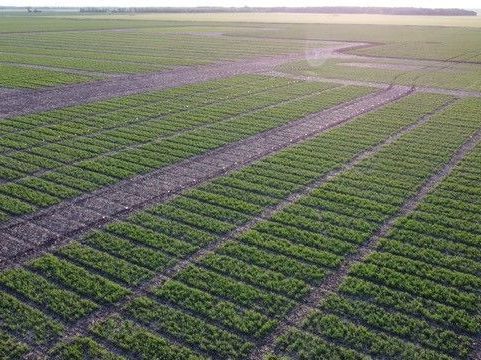New grape hybrids: Researchers unite Muscadines and Vitis vinifera
$7M USDA-NIFA-SCRI grant supports effort to improve grape disease resistance, quality
Advertisement
Muscadines may be the folksy American of the grape world, but they have many qualities like disease resistance and unique flavors that are desired in the more popular Vitis vinifera (bunch grapes) species.

Margaret Worthington, left, and Renee Threlfall with the University of Arkansas System Division of Agriculture are co-directors of a national project supported by the U.S. Department of Agriculture to crossbreed muscadines and Vitis vinifera grapes for shared desirable traits. Worthington is associate professor of horticulture and director of the Arkansas Fruit Breeding Program. Threlfall is associate professor of enology and viticulture in the food science
U of A System Division of Agriculture photo by Paden Johnson
Likewise, Vitis vinifera — the species that most people eat as table grapes and drink in wine — has many characteristics desirable for muscadines, like thinner skin, a crispier texture and seedlessness. Successfully combining traits from these two species of grapes is a challenge due to differing numbers of base chromosomes.
With support from a $7 million grant from the U.S. Department of Agriculture’s National Institute of Food and Agriculture, a 32-person team from across the nation is working to bring these two species of grapes together and improve this high-valued fruit crop. In 2022, there were nearly 1 million acres of grape-bearing land in the United States producing grapes for fresh and processing markets worth $6.5 billion.
“Through the Grapevine: Developing Vitis x Muscadinia Wide Hybrids for Enhanced Disease Resistance and Quality” unites scientists from 12 institutions. Research and extension efforts will be integrated through collaborations with industry partners including 14 advisory board members and 38 stakeholders. The four-year Specialty Crop Research Initiative project is part of a recently announced $70.4 million USDA-NIFA investment to support specialty crop production research across the country.
Dubbed VxM (Vitis x Muscadinia) for short, the project is co-directed by Renee Threlfall and Margaret Worthington with the Arkansas Agricultural Experiment Station, the research arm of the University of Arkansas System Division of Agriculture. The other project team members are from the University of California-Davis, Clemson University, Cornell University, Florida A&M University, the University of Florida, the University of Georgia, the University of Kentucky, Mississippi State University, North Carolina State University, Texas A&M University, and the USDA Agricultural Research Service.
A decade in the making
“This project has been a decade in the works, waiting for the right project partners to form this team,” said Threlfall, associate professor of enology and viticulture in the food science department. “A lot of planning and collaboration made this opportunity a success. Our goal is the introduction of disease-resistant cultivars with enhanced fruit quality leading to a more resilient U.S. grape industry.”
In addition to building relationships with project partners across the country over the past decade, Threlfall said a key person making the project possible is Worthington, associate professor of horticulture and director of the Arkansas Fruit Breeding Program for the experiment station.
Worthington, a North Carolina native, is an unapologetic muscadine fan, having grown up in a family and community that regarded them as “highly valued” and a treat at harvest. Unlike most of the country, muscadines were available at her local grocery store. Worthington said she wants to tame this special native grape to make it more appealing for grape growers and consumers.
Breeding efforts between Vitis and Muscadinia to create wide hybrids have already begun in Europe and the United States, Threlfall noted, resulting in new grape cultivars. Some have attributes of Vitis, some of Muscadinia, but many cultivars have attributes of both.
New table grape varieties like Candy Hearts™ and Cotton Candy™ show that consumers are excited about new bold flavors for fruit, Worthington noted. But the genetics for disease resistance are lacking in Vitis grapes, and there is still work needed to make muscadines more appealing to a broader consumer base.
Muscadines can grow much larger than Vitis species, sometimes as big as golf balls, and they are grown commercially in the Southeast for fresh-market and processing into wines, juices and jellies. As compared to Vitis species, Muscadines tend to have thick skins, a different texture, distinct fruity-floral flavors, and berries containing large seeds. They also have 20 chromosomes, one more than bunch grapes, so breeding between these two subgenres can be complicated, Worthington noted.
“It’s like crossing a horse and a donkey … you get a mule that is highly sterile,” Worthington said. “When you cross muscadines with bunch grapes you get more grapes and can back breed with the goal of having a disease-resistant bunch grape or a muscadine with improved traits.”
Six objectives
The project has six objective-based teams focused on genetics, breeding, pathology, quality, marketing and production. Threlfall leads the team focused on quality, and Worthington leads the breeding team. The goal is to develop new grape hybrids combining the best attributes of muscadines and bunch grapes, Worthington said.
Marker-assisted breeding will be used as part of the project and helps speed up the traditional grape breeding and plant selection process. Scientists can examine a plant’s genetic markers to identify favorable traits in the plants before time-consuming efforts of field testing.
Qi Sun, research scientist and co-director of the bioinformatics facility at Cornell University, leads the genetics team for VxM and noted the level of difficulty for this project.
“Breeding hybrids is a common practice in crop improvement, but not always easy due to the difficulty in producing fertile progenies,” Sun said. “This project gives us a unique opportunity to systematically study the genetics of the muscadine and European grape hybrids, to have a better understanding of the biological barriers for crossing between these two different grapes and how to overcome them.”
“We’re trying to provide the grape breeders more genetic markers to do their jobs, especially for breeding, genetics and pathology,” Threlfall added. “The quality element for new grapes is mostly about flavor and texture, and the marketing element is about what growers and consumers perceive. It’s like if you were inventing a new fruit, you have to ask a consumer, ‘Would you try it?’”
Melinda Knuth, assistant professor at North Carolina State University, is the marketing team lead. With the fresh-market muscadine grape industry largely localized in the Southeast, this team seeks to find out what it would take to gain national interest in new grape varieties and other key factors related to cost, logistics and consumer demand.
“The marketing and economic team members will be answering these questions through appraising the supply chain, seeking input from growers, evaluating the introduction success of similar product types and gauging consumer demand,” Knuth said.
Disease-tolerant traits that can be valuable to the broader U.S. grape and wine industry are desired due to challenging climates in grape-growing regions, evolving pathogens and shifting consumer markets, Threlfall said.
Why Vitis and Muscadinia?
Plant diseases and pests result in billions of dollars in economic losses and management inputs each year in the United States. Without pest control, 70 percent of crop yields could be lost, according to the USDA-Agricultural Research Service’s Plant Disease Action Plan for 2022-2026.
Lance Cadle-Davidson, research plant pathologist for the USDA-ARS, leads the pathology team for VxM and explained the importance of continued research in disease resistance.
“Bunch grapes are susceptible to many diseases that muscadines resist naturally,” Cadle-Davidson said. “In fact, the two most widely used resistance genes in breeding new bunch grape cultivars come from muscadines, from a cross hybridization made in 1917.”
In contrast, he said, this project aims to provide grape and muscadine breeders with 10 disease-resistance genes in just four years, targeting powdery mildew, downy mildew, black rot and grapevine leafroll-associated virus 3.
Broadening horizons
Mark Hoffmann, associate professor and extension specialist with North Carolina State University, leads the production team and hopes the results will open new areas for grape production.
“Hybrid grapes have a large potential, especially in areas in which traditional grape production is difficult and not cost-effective,” Hoffman said. “This project allows us to evaluate germplasm as well as muscadine and hybrid cultivars across a large region of the southern United States and bring the potential of those cultivars closer to the grower.”
University of Arkansas System faculty members Amanda McWhirt, associate professor and extension fruit specialist with the Division of Agriculture, and Scott Lafontaine, assistant professor and flavor chemist with the Dale Bumpers College of Agricultural, Food and Life Sciences, are also working on VxM. McWhirt is on the eight-person production team led by Hoffmann and Lafontaine is among the six-person quality team led by Threlfall.
The work is supported by the Specialty Crop Research Initiative, project award no. 2024-51181-43236, from the U.S. Department of Agriculture’s National Institute of Food and Agriculture.
Mention of product names by the University of Arkansas System Division of Agriculture does not imply endorsement.


































































